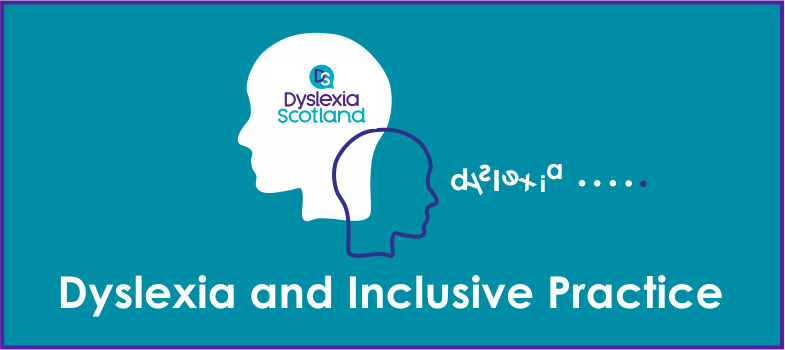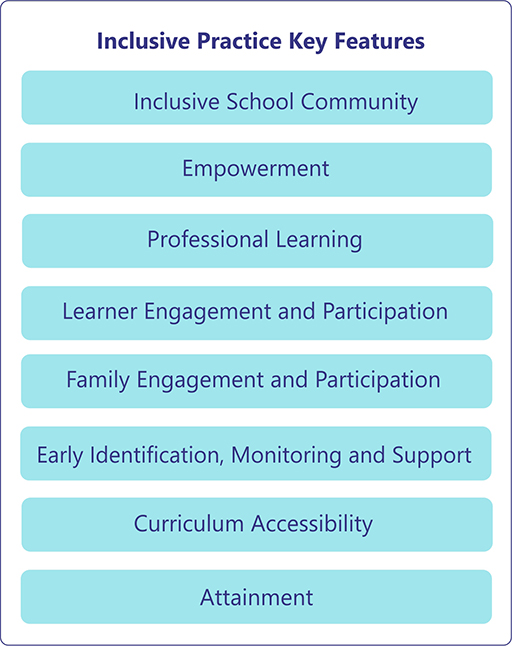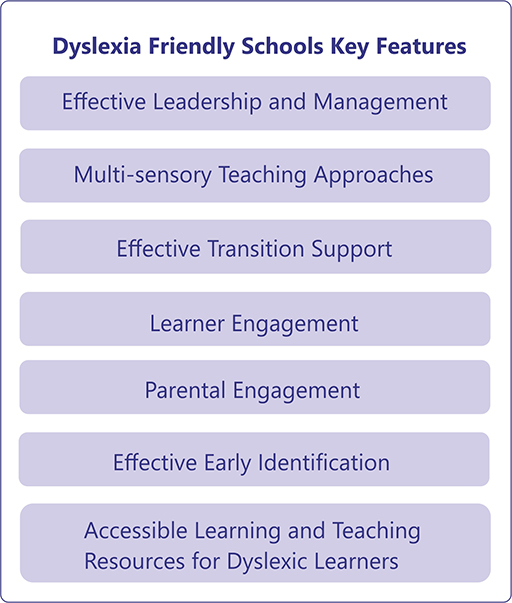1.6. Dyslexia and inclusive practice
Module 1, Section 3 Recap
Dyslexia friendly approaches to learning and teaching support child-centred inclusive practice.
What are Dyslexia Friendly Schools?
Neil Mackay developed the ‘Dyslexia Friendly Schools’ concept in 1998. The key aims of Dyslexia Friendly Schools were to enhance the impact of learning and teaching on the child in the classroom and to ensure that teaching was multi-sensory and benefited all children, not just those with dyslexia. The approach has developed over the years and is inclusive and holistic, reflecting current research on effective positive learning for children with literacy difficulties.
Key features of Dyslexia Friendly Schools are:
- Effective leadership and management
- Multi-sensory teaching approaches
- Effective early identification
- Effective transition support
- Learner engagement
- Parental engagement
- Learning and teaching resources which can accessed by dyslexic learners
What is Dyslexia Friendly Practice?
Dyslexia Friendly Practice is an important element of inclusive practice. It includes approaches to learning and teaching which are child-centred and also support inclusive practice for all learners. A number of initiatives are supporting the development, recognition and implementation of inclusive practice within Scottish education with the aim of improving the educational experiences and outcomes of learners who are dyslexic. These are:
- Current education policies and legislation which support inclusion and equality legislation
- Professional duties e.g. General Teaching Council for Scotland
- Self-evaluation frameworks to support improvement
- Acceptance that dyslexia exists and awareness of the neurological, genetic and environmental factors which impact on dyslexia
- Availability of a free national online resource, the Addressing Dyslexia Toolkit, which supports inclusive practice
- Improved understanding of an “holistic/collaborative” assessment for dyslexia
- The 2014 ‘Making Sense Review’ recommendations – Improving outcomes for dyslexic learners
- Improving understanding of links between effective support for dyslexia and inclusive practice for all learners.
It is the responsibility of schools and their partners to bring the experiences and outcomes together and apply these entitlements to produce programmes for learning across a broad and inclusive curriculum.
Every child and young person is entitled to expect their education to provide them with:
- A curriculum which is coherent from 3 to 18
- A broad general education, including well planned experiences and outcomes across all the curriculum areas from early years through to S3
- A senior phase of education after S3 which provides opportunities to obtain qualifications as well as to continue to develop the four capacities
- Opportunities to develop skills for learning, skills for life and skills for work (including career planning skills) with a continuous focus on literacy, numeracy and health and wellbeing
- Personal support to enable them to gain as much as possible from the opportunities which Curriculum for Excellence can provide
- Support in moving into positive and sustained destinations beyond school.
Activity 9 Reflective practice task
1. In your Reflective Log, consider:
- What does inclusive practice mean for you?
- What does inclusive practice mean for your learners?
- What have you done to make your teaching practice inclusive?
2. Complete the following table to describe the current practice in your class or department. Identify if any actions can be taken to support improvements. (A copy of this table is in your Reflective Log)
| Key features of Dyslexia Friendly schools | In my class/department this means | Actions |
| Effective leadership and management | ||
| Multi-sensory teaching approaches | ||
| Effective early identification | ||
| Effective transition support | ||
| Learner engagement | ||
| Parental engagement | ||
| Learning and teaching resources which can be accessed by dyslexic learners |
Inclusive practice is about meeting the needs of all learners, putting the learner at the centre of the curriculum and ensuring that barriers are removed. This will enable them to:
- Participate and learn to the best of their ability
- Gain as much as possible from the opportunities which Curriculum for Excellence can provide
- Move into a positive and sustained post school destination.
Activity 10
Consider the aims of inclusive practice listed above.
What do you feel they can/should look like in practice?
Note down your thoughts within your Reflective Log. Click ‘Reveal discussion’ to see an example of each.
- Participate and learn to the best of their ability.
Consider what can this look like?
Discussion
An example could be that learners are engaging in learning activities and experiences which match their cognitive ability and provide challenge and interest. To support this, an understanding of the learners’ profile is required to plan appropriate learning and teaching activities.
- Gain as much as possible from the opportunities which Curriculum for Excellence can provide
Consider what can this look like?
Discussion
An example could be that the school curriculum is flexible and personalised to meet the needs of learners with additional support needs, ensuring that there is equity and equality in curriculum accessibility. To support this, flexibility and creativity is involved when planning and timetabling the curriculum, which includes a range of award bearing courses and vocational opportunities and experiences.
- Move into a positive and sustained destination.
Consider what can this look like?
Discussion
An example could be that the attainment levels of learners with dyslexia are in line with their peers. To support this all teachers must be involved in appropriate:
- Monitoring and tracking of learners’ progress to support early intervention
- Arrangements for assessment and tracking to provide personalised guidance and support throughout the learner journey
- Use of data to inform effective planning and support
Dyslexia and Inclusive Practice: Professional Learning Resource

A reflective and evaluative professional learning approach to improve practice and empower whole school approaches to support learners.
This professional learning resource focuses on eight key areas that were developed through stakeholder consultation (Figure 7), to support improvements in the outcomes for all learners including learners with dyslexia. These are very similar to the key features of Dyslexia Friendly schools in Figure 6.
This professional learning resource is one of several free resources that have been developed in response to the 2014 Education Scotland report Making Sense: Education for Children and Young People with Dyslexia in Scotland.
Developed by Education Scotland, the Making Sense Working Group and stakeholders, it aims to support practitioners, schools and local authorities to:
- Improve the quality of educational outcomes for learners with dyslexia through collaborative enquiry and effective self-evaluation
- Evidence the impact of the collaborative enquiry through evidence-based improvements
- Fulfil statutory duties
- Support professional learning on inclusive practice
- Further develop inclusive practice for all learners within the school community.
- Build on partnerships within the Regional Improvement Collaboratives (RICs), developing opportunities to share practice and reduce duplication of resource development.
The level of awareness and readiness for change will vary across schools and local authorities and this resource can be used to focus on specific key areas for improvement or to contribute to whole school inclusive practice.
Section 3, Supporting learners and families provides you with an opportunity to explore the Scottish curriculum and inclusion.

Activity 11 Reflective Log
- Have we successfully established an inclusive school community? How do we know – what is the evidence and impact?
- Are all our school policies and planning methods inclusive – do they fulfil the statutory and professional duties?
- How do we consult with and involve all stakeholders in the self-evaluation of inclusive practice and support for dyslexia?
Supporting improvement
‘How Good Is Our School 4’ (HGIOS 4) is a resource to support improvement through self-evaluation and inclusion and is embedded across all the themes and quality indicators.
The table below highlights how the reflective questions can support school communities evaluate their inclusive practice and identify areas for improvement.
Activity 12
a.
1.1 Self-evaluation for self-improvement
b.
1.2 Leadership of learning
c.
1.3 Leadership of change
d.
1.4 Leadership and management of staff
e.
1.5 Management of resources to promote equity
f.
2.1 Safeguarding and child protection
g.
2.2 Curriculum
h.
2.3 Learning, teaching and assessment
i.
2.4 Personalised support
j.
2.5 Family learning
k.
2.6 Transitions
l.
2.7 Partnerships
m.
3.1 Ensuring wellbeing, equality and inclusion
n.
3.2 Raising attainment and achievement
o.
3.3 Increasing creativity and employability
The correct answers are a, b, c, d, e, f, g, h, i, j, k, l, m, n and o.
Answer
Inclusive practice is featured across all 3 themes and the 15 Quality Indicators within HGIOS 4.
Discussion
This self-evaluation framework is designed to promote effective self-evaluation as the first important stage in a process of achieving self-improvement. Reflecting on inclusion when evaluating practice to see what is working well and what needs to improve will support the educational experiences and outcomes for dyslexia and other additional support needs.
1.5. Raising attainment, dyslexia and inclusive practice




